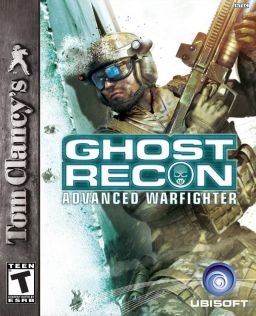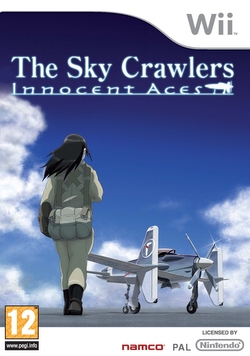
A joystick, sometimes called a flight stick, is an input device consisting of a stick that pivots on a base and reports its angle or direction to the device it is controlling. A joystick, also known as the control column, is the principal control device in the cockpit of many civilian and military aircraft, either as a centre stick. It has various switches to control the movements of the aircraft controlled by the Pilot and First Officer of the flight.

Tom Clancy's Ghost Recon is a tactical shooter video game developed by Red Storm Entertainment and published by Ubi Soft in 2001 for Microsoft Windows. It is the first game in the Ghost Recon series. It was ported to Mac OS, PlayStation 2 and Xbox in 2002 and to the GameCube in 2003. Ports for N-Gage and Game Boy Advance were planned, but later canceled. Unlike Clancy's other tactical shooter series, Rainbow Six, Ghost Recon is not based on any of his books.

Aerial warfare is the use of military aircraft and other flying machines in warfare. Aerial warfare includes bombers attacking enemy installations or a concentration of enemy troops or strategic targets; fighter aircraft battling for control of airspace; attack aircraft engaging in close air support against ground targets; naval aviation flying against sea and nearby land targets; gliders, helicopters and other aircraft to carry airborne forces such as paratroopers; aerial refueling tankers to extend operation time or range; and military transport aircraft to move cargo and personnel.
Tom Clancy's Ghost Recon is a series of military tactical shooter video games published by Ubisoft. In the series, the player is in charge of a fictional, newly conceived squad of U.S. Army Special Forces soldiers from Delta Company, 1st Battalion, 5th Special Forces Group stationed at Fort Bragg. Except for the "1st Battalion, 5th SFG" designation, this reconnaissance unit is entirely fictional, as Special Forces Battalions currently only support three Companies. They are often referred to as "the Ghosts". Their role is like other real world special operations forces, in that their operations are kept highly classified. In Tom Clancy's Ghost Recon: Future Soldier, it is shown that the Ghost's unit has multiple designations and is part of JSOC; they are also known as the Group for Specialized Tactics, much like real JSOC units such as Delta Force and SEAL Team Six. Tom Clancy's Ghost Recon has also been novelized by Grant Blackwood under the pseudonym David Michaels.

Tom Clancy's Ghost Recon 2 is a tactical shooter video game developed by Red Storm Entertainment and published by Ubisoft for Xbox, PlayStation 2 and GameCube. A Microsoft Windows version was planned but cancelled in April 2005 in favor of Tom Clancy's Ghost Recon Advanced Warfighter. It is a direct sequel to the 2001 video game Tom Clancy's Ghost Recon.

The S-75 is a Soviet-designed, high-altitude air defence system. It is built around a surface-to-air missile with command guidance. Following its first deployment in 1957 it became one of the most widely deployed air defence systems in history. It scored the first destruction of an enemy aircraft by a surface-to-air missile, with the shooting down of a Taiwanese Martin RB-57D Canberra over China on 7 October 1959 that was hit by a salvo of three V-750 (1D) missiles at an altitude of 20 km (65,600 ft). This success was credited to Chinese fighter aircraft at the time to keep the S-75 program secret.

Tom Clancy's Ghost Recon Advanced Warfighter (GRAW) is a tactical shooter video game released for the Xbox 360, Xbox, PlayStation 2 and Microsoft Windows in 2006. As in previous Ghost Recon games, players command their team while neutralizing hostile forces and completing various mission objectives. These objectives can range from escorting friendly units across the map to rescuing hostages or taking out enemy artillery.

Tom Clancy's Ghost Recon Advanced Warfighter 2 is a tactical shooter video game developed by Ubisoft Paris and Red Storm Entertainment and published by Ubisoft. It was released for Xbox 360, Microsoft Windows, PlayStation 3 and PlayStation Portable. It is the sequel to Tom Clancy's Ghost Recon Advanced Warfighter. High Voltage Software developed the game's PlayStation Portable version, while Grin developed the Windows version.
Tom Salta, also known as Atlas Plug, is an American recording artist and soundtrack composer. He has composed soundtracks for many videos games titles, including Tom Clancy's Ghost Recon Advanced Warfighter 1 & 2, Cold Fear, Red Steel and Tom Clancy's H.A.W.X. Salta's score for Red Steel received an award for "Best Original Score" in IGN's Best of 2006 awards. Salta works in multimedia including film, television, advertising, and video games.

Tom Clancy's EndWar is a strategy video game available on Microsoft Windows and all seventh-generation platforms except the Wii, with the timing and flow of gameplay differing across platforms. The console and PC version is a real-time tactics game designed by Ubisoft Shanghai, while the handheld versions feature turn-based tactics. It was released on Nintendo DS, PlayStation 3, PlayStation Portable, and Xbox 360 in November 2008. A Windows version was released in February 2009.

Tom Clancy's H.A.W.X is an arcade flight video game developed by Ubisoft Bucharest and published by Ubisoft for Microsoft Windows, Xbox 360 and PlayStation 3, and by Gameloft for BlackBerry PlayBook, iOS, Palm Pre, Android and Symbian^3. It was released for Xbox 360 and PlayStation 3 in North America on March 3, 2009, for Windows on March 17, for iOS on December 9, for BlackBerry on January 8, 2010, for Palm Pre on April 2, for Android on September 13, and for Symbian on January 16, 2011. A Wii version was announced, but was ultimately canceled. In September 2010, a sequel titled Tom Clancy's H.A.W.X 2 was released for Xbox 360 and PlayStation 3. The Microsoft Windows and Wii versions were released in November 2010. In November 2018, Tom Clancy's H.A.W.X was added to the Xbox One's Backwards Compatibility list although only through physical media as it's not available on the Xbox Marketplace.

Tom Clancy's Ghost Recon: Future Soldier is a third-person tactical shooter video game developed and published by Ubisoft for the PlayStation 3, Xbox 360 and Microsoft Windows. It was released in May and June 2012. Tom Clancy's Ghost Recon: Future Soldier was announced to be in development by Ubisoft on January 22, 2009. The game has a futuristic take on the Ghost Recon series. The campaign has settings such as Bolivia, Zambia, Nigeria, Pakistan, Russia, and Norway.

The Sky Crawlers: Innocent Aces is a 2008 air combat arcade game for the Wii based on the anime film adaptation of Hiroshi Mori’s novel series The Sky Crawlers, as a tie-in prequel to the film. Developed by Project Aces in collaboration with Access Games, the game was released in Japan by Namco Bandai Games on 16 October 2008. Xseed Games released the game in North America on January 12, 2010. It was also released by Namco Bandai Games in Europe on February 26, 2010 and in Australia on March 25, 2010.

Tom Clancy's Ghost Recon: Shadow Wars is a turn-based tactics video game for the Nintendo 3DS developed and published by Ubisoft in 2011. The game is part of the Ghost Recon series of the Tom Clancy games. First images of the game were leaked by IGN in 2010. The game was released on March 25, 2011 in Europe, March 27 in North America, and March 31 in Australia as a launch title for Nintendo's new console. It was later released in Japan on May 19, 2011. The game released in North America five days before the Nintendo 3DS North American launch.

Tom Clancy's Ghost Recon is a tactical shooter video game developed by Next Level Games and published by Ubisoft exclusively for the Wii. The game, set in modern day Norway and Russia, follows the efforts of two United States Army Rangers in toppling a fictional ultranationalist Russian regime.
The following is a complete list of books published by Tom Clancy, an American author of contemporary spy fiction and military fiction.

Tom Clancy's is a branding used by video game company Ubisoft for several video games, some of which feature the works of American author Tom Clancy, while others do not. Various sub-series are often unrelated to each other with a few exceptions, although most are shooters set in modern or near-future military settings.














